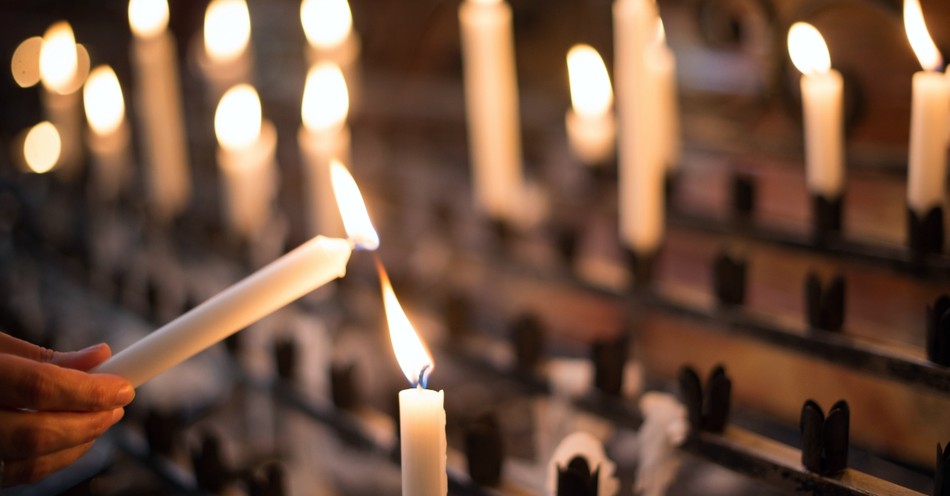Tenebrae is a religious service that occurs during the Holy Week. It is commonly held on Good Friday, the day Christ died on the cross. Catholic, Orthodox, and Protestant Christians observe Tenebrae services where believers gather to reflect on the events of Jesus’ death.
Guide to Tenebrae Service: Table of Contents
- What is a Tenebrae Service?
- Meaning of Tenebrae
- Tenebrae in the Bible
- Guide to a Tenebrae Service
- End of Tenebrae
- Tenebrae Meditation
- Bible Verses for Tenebrae"
What is a Tenebrae Service?
A special candelabra is used during Tenebrae, which usually has fifteen candles. After each reading, whether from the Psalms or gospels, a candle is extinguished until one is left. By the end of the service, the church is cast into darkness, except for the continual light of the Christ candle.
While believers are considering the significance of the darkness, a loud noise is heard, either from an instrument, a book dropped on the floor or church bells.
As a service with deep biblical meaning, each part of Tenebrae sets the mood for the congregation as they consider the darkness of that day as the Savior hung on the cross and died for the sins of the world.
Meaning of Tenebrae
Stemming from Latin, the word “Tenebrae” means “darkness.” Such a definition is suitable for this service, which centers around the increasing darkness of the church as the lights on the candelabra are extinguished.
The darkness not only provides an atmosphere of reflection on Christ’s death but also symbolizes the darkness that Jesus experienced as He hung on the cross.
Tenebrae in the Bible
The Synoptic Gospels record the interesting and important fact that darkness covered the land during Jesus’ crucifixion (Matthew 27:45; Mark 15:33; Luke 23:44). Many biblical scholars and scientists have speculated if the darkening of the sun was due to a solar eclipse at that time.
Scripture, however, indicates that the shroud of darkness over the land was a supernatural sign of judgment on sin. That day was not like any other since a world-changing event was happening — Jesus was enduring the sins of all mankind.
As Isaiah prophesied, Christ “was pierced for our transgressions, he was crushed for our iniquities; the punishment that brought us peace was on him, and by his wounds we are healed” (Isaiah 53:5).
Because of the sins placed on Him, Jesus experienced the pain of being separated from the Father. In His holiness, God the Father looked away from the Son who bore our sins in His body (1 Peter 2:24).
Feeling the darkness of His separation, Jesus cried out, “My God, my God, why have you forsaken me?” (Matthew 27:46).
Guide to a Tenebrae Service
During a Tenebrae service, believers are gradually immersed into a physical setting of darkness, allowing us to reflect on Jesus’ suffering, the darkness that covered the land at His crucifixion, His separation from the Father, and the seriousness of our sin.
When the candles are extinguished, we are reminded of the costly payment for our wrongdoing, the sacrifice of the perfect Lamb of God (John 1:29).
Although most of the flames on the Tenebrae candelabra are extinguished, the Christ candle (which is the last candle, typically in the middle) stays lit in the darkness. Different churches place this candle in key places, sometimes behind the altar or in front of it.
In many churches, the candelabra is deliberately taken away from the altar and hidden from view at the end of the service. Satan and the powers of darkness may have thought they had won in Jesus’ death, but the burning light of the Christ candle reminds us of our Savior’s victory.
Like the hidden candle, Jesus’ death seemed to mark the end of hope. The disciples did not understand Jesus’ death and were confused why He had not restored Israel.
They even told Jesus, who they did not recognize at the time, that His death was confusing to them since “we had hoped he was the Messiah who had come to rescue Israel” (Luke 24:21, NLT).
Despite Jesus’ repeated instruction about His mission in coming to the world to save it through His death and resurrection, the disciples failed to comprehend the meaning of His death (Matthew 16:21; 20:28; Mark 10:45). All they knew was that their Leader was dead, which left them hopeless.
The powers of darkness may have boasted over Jesus’ death on the cross, but He had the final word. As the Light of the World, the darkness could not overcome Him (John 1:5). Satan assumed that Jesus was defeated at the cross.
However, the opposite is true. As the Apostle Paul explained in Colossians 2:14-15, Jesus “canceled the record of the charges against us and took it away by nailing it to the cross. In this way, he disarmed the spiritual rulers and authorities. He shamed them publicly by his victory over them on the cross” (NLT, emphasis mine).
Jesus defeated Satan and the power of death (Hebrews 2:14).
The image of the Christ candle, unextinguished, during the Tenebrae service points to the reality of Jesus’ mission, victory on the cross, and the assured hope of the resurrection. Life seemed dark to the disciples on Friday, but the light of Sunday was coming.
End of a Tenebrae Service
At the end of a Tenebrae service, a loud sound is heard in the darkness, called a strepitus. In Latin, the word “strepitus” refers to a loud noise or crashing sound.
Through the visual representation of darkness and the auditory experience of strepitus, believers are immersed in a church service with rich scriptural meaning.
Just as the darkness and Christ candle hold symbolic meaning, so also does the loud sound at the end of Tenebrae, which is associated with the events of Jesus’ death and his burial in the tomb.
When Jesus gave up His life on the cross, committing His spirit to the Father, major events happened (Matthew 27:50 and Luke 23:46).
Not only was the darkness still present, but “the curtain of the temple was torn in two from top to bottom. The earth shook, the rocks split, and the tombs broke open. The bodies of many holy people who had died were raised to life” (Matthew 27:51-52).
In amazement and fear of the earthquake, the centurion standing near the cross at Jesus’ death proclaimed, “Surely he was the Son of God” (Matthew 27:54). Even the Roman centurion understood that Christ’s death was not ordinary.
The torn Temple curtain showed that the way to God was open and available to everyone through Jesus (Matthew 27:51; John 14:6). Also, the open tombs at His death signified Christ’s triumph over death (Matthew 27:52; 1 Corinthians 15:55-57).
Likewise, the earthquake was not secondary. As a biblical commentator has noted, “The death of Christ was a powerful, earthshaking event with repercussions affecting even the creation” (Barbieri Bible Knowledge Commentary: New Testament edition).
The strepitus at the end of the Tenebrae service reminds us of the significance of Jesus’ death, which affected creation itself.
Another interpretation of the loud noise at the end of Tenebrae is that it signifies the closing of the tomb. Jesus was buried by Joseph of Arimathea and Nicodemus on Friday before the Sabbath began (John 19:38-42).
They prepared Jesus’ body as best they could and then sealed the tomb. Although many believers may wonder why we need to be reminded of Jesus’ burial, it is essential to the gospel message (1 Corinthians 15:1-4).
Christ truly died. He did not lose consciousness and revive in the tomb. He died a physical death on the cross and His body was placed in a tomb.
The Lord undoubtedly foresaw the accusations of skeptics, which is why He ensured the gospels included a record of the burial in His Word (see Matthew 27:57-61; Mark 15:42-47; Luke 23:50-55; John 19:38-42).
If Christ had not been buried, then the claim of an empty tomb would be dubious. As it is, Jesus’ dead body was buried, but the tomb was empty on Sunday, demonstrating He rose from the dead.
Meditating on Christ’s Sacrifice
Therefore, all the elements of the religious service Tenebrae have deep spiritual and biblical meaning. The candles, darkness, and strepitus urge believers to meditate on Christ’s sacrificial death.
Our sins were placed on Jesus as He hung on the cross, which caused Him to experience the darkness of sin and the separation from the Father. The salvation that is offered freely to all who believe came at a great cost to the Lord, who poured out His life for us.
Because we can so often forget the depth of our sins and Christ’s loving sacrifice, the service of Tenebrae invites us to reflect on what Christ did that “Good Friday.”
He triumphed over the powers of darkness, defeated death, and completed His earthshaking mission of redemption. During a Tenebrae service, we remember the darkness Jesus endured as we look forward to the light of Easter — the resurrection.
Bible Verses for Tenebrae Service
My God, my God, why have you forsaken me? Why are you so far from saving me, so far from my cries of anguish? My God, I cry out by day, but you do not answer, by night, but I find no rest.
He was despised and rejected by mankind, a man of suffering, and familiar with pain. Like one from whom people hide their faces, he was despised, and we held him in low esteem. Surely he took up our pain and bore our suffering, yet we considered him punished by God, stricken by him, and afflicted. But he was pierced for our transgressions, he was crushed for our iniquities; the punishment that brought us peace was on him, and by his wounds, we are healed.
Going a little farther, he fell with his face to the ground and prayed, "My Father, if it is possible, may this cup be taken from me. Yet not as I will, but as you will."
From noon until three in the afternoon darkness came over all the land. About three in the afternoon, Jesus cried out in a loud voice, "Eli, Eli, lema sabachthani?" (which means "My God, my God, why have you forsaken me?").
When he had received the drink, Jesus said, "It is finished." With that, he bowed his head and gave up his spirit.
For we do not have a high priest who is unable to empathize with our weaknesses, but we have one who has been tempted in every way, just as we are—yet he did not sin. Let us then approach God's throne of grace with confidence, so that we may receive mercy and find grace to help us in our time of need.
I am the man who has seen affliction by the rod of the Lord’s wrath. He has driven me away and made me walk in darkness rather than light. Indeed, he has turned his hand against me again and again, all day long.
It was now about noon, and darkness came over the whole land until three in the afternoon, for the sun stopped shining. And the curtain of the temple was torn in two. Jesus called out with a loud voice, "Father, into your hands I commit my spirit." When he had said this, he breathed his last.
And being found in appearance as a man, he humbled himself by becoming obedient to death—even death on a cross!
For further reading:
What Are the Days That Make Up Holy Week before Easter?
How Did Jesus Scorn the Shame of the Cross?
What Is the Significance of the Cross?
What Happened During Jesus’ Last Hours Before His Death?
Photo Credit: ©iStock/Getty Images Plus/killerbayer




.jpg)